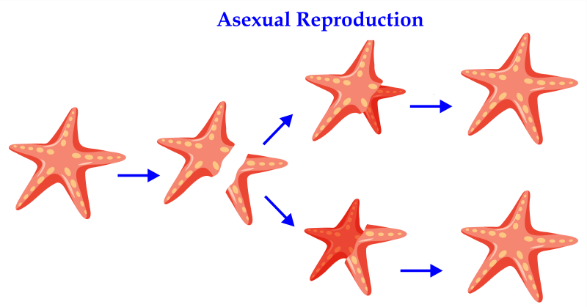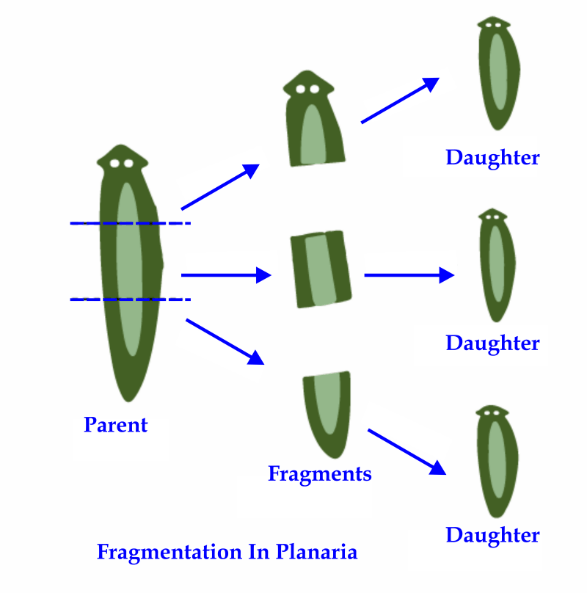Advantages and Disadvantages of Asexual ReproductionAnimals and plants utilize one of two reproductive strategies to guarantee the survival of their species. Two parents participate in the "normal" reproductive procedure. The offspring is then created by combining the DNA of the parents. One parent can have offspring through asexual reproduction. Successfully producing kids without a relationship is the main benefit of asexual reproduction. It takes place over a brief amount of time without the requirement for the genetic makeup of gender to mature. In exchange, the progeny will have the same traits as their parents. Asexual reproduction has the drawback of slowing the evolutionary process. This technique produces children that are almost entirely clones of the parents and almost invariably belong to the same species. Due to the species' limited evolutionary growth, its negative traits are persistently passed down from generation to generation. Definition of Asexual ReproductionWhen an organism multiplies itself without sexually reproducing with another organism, this process is known as sexless reproduction. The genomes of two parents are mixed in sexually reproducing organisms to produce offspring with distinct genetic profiles. The population will benefit from this because genetically varied people are more likely to survive threats to their existence, such as illness and climatic changes. However, they may also reproduce more quickly than sexually reproducing creatures, and a single individual can start a new colony without the aid of a mate. Asexually breeding species can suffer from a severe lack of diversity. Asexually reproducing animals like bacteria that spread DNA fragments via plasmids are examples of how horizontal gene transfer is used to share genetic material and increase variety. However, compared to sexual reproduction, this approach produces fewer unique genes. Depending on the requirements of the environment, several species of plants, animals, and fungi are capable of sexual and asexual reproduction. Most single-celled creatures, such as bacteria, archaebacteria, and protists, reproduce asexually. Some animals, fungi, and plants also engage in it. 
Advantages of Asexual Reproduction
The energy needs during the whole cycle of reproduction are decreased since just one parent is necessary for this reproductive process. Sex is not required. This implies that there is no need to use energy to combine genomes. A species may transmit knowledge to the following generation more readily.
Being asexual makes organisms more adaptable. They may change their appearance or adjust to shifting conditions and yet be able to procreate. The organism can access some evolutionary movement thanks to its flexibility, even though only one parent participates in the reproduction process. If an organism can endure in the environment where it first emerged, it can flourish there, given that the ecosystem's circumstances stay the same throughout time.
Since asexual reproduction is simply cloning, external assistance is not required for reproduction. The parent may clone itself and break an offspring off from the reproductive cycle without needing a partner or pollination. An organism can discover a favorable home and then reproduce in large numbers without the risk of passing on randomized genetic material since variety can be restricted beneficially.
All the advantageous characteristics of the species are practically assured to be handed on since the offspring produced via the process of asexual reproduction is essentially a replica of the parent. This means that an asexual organism's main characteristics can enable it to take advantage of the limited opportunities for evolutionary development that are accessible to it.
Asexual reproduction can take place in three different ways. The first is when development originates from the parent and is referred to as "budding." The potato is one of the most famous instances of this kind of replication. The second referred to as "propagation," occurs when a plant creates "runners" to expand its population of plants. A notable illustration of this mechanism is strawberry growth. The third, known as fragmentation, enables a part of one creature to eventually develop into a whole parent. Cuttings can be used to cultivate Chinese evergreens, African violets, and begonias. Fission and spores are other potential reproduction strategies.
For people who sexually reproduce, a relationship must be formed before a colony may be started. This is not required for asexual reproduction. A settlement may grow almost any size using only one parent to create daughter cells. This creature may outcompete other organisms in that environment for the available resources once a colony has been established.
Because of the cycles of nature, smaller creatures frequently suffer at the hands of larger ones. Smaller organisms can reproduce thanks to asexual reproduction indefinitely, especially when it's possible for them to remain stationary for the duration of their entire life cycle. Due to the decreased energy needs involved in the process, more offspring may be generated, and they can be produced more often.
Modern culture uses specific crops extensively. Jasmine and sugarcane are two typical examples. Large crops of these essential commodities may now be multiplied even if they do not grow from seeds or have seeds because of asexual reproduction. Compared to plants that need pollination or sexual reproduction, those that are developed by asexual reproduction also often bear their fruit sooner in the growing season.
Throughout a growing season, every crop will endure some amount of loss. Asexual reproduction makes it feasible to quickly replenish the present crop generation to increase yields. Using the propagation procedures associated with this reproduction cycle, even organisms sustaining damage can be healed.
Maturity for plants that use the asexual reproductive cycle can occur in as little as six weeks. The maturation process for a crop yield can take several months for plants that rely on sexual reproduction. In some environments, multiple outcomes are possible due to the shortened growing period. Disadvantages of Asexual Reproduction
Any undesirable mutations present in the organism's genetic makeup will be passed on to the offspring since an asexual organism's child is essentially a parent clone. This increases the likelihood that an asexual species would eventually become extinct because most mutations tend to be more harmful than beneficial, especially given the limited amount of evolution to which such a species has access.
Asexual organisms have very little genetic variety since only one parent participates in reproduction. Due to the inability to adapt to or combat such an issue, a species becomes more vulnerable to numerous illnesses or infections. Without outside assistance, many asexual creatures would have to evolve gradually to increase genetic variety or have minimal populations.
For many asexual species, the reproductive process occurs more frequently than sexual reproduction because it is more straightforward. This implies that a species' population numbers can overgrow, particularly in favorable environmental factors that promote the reproductive cycle. When there is no rivalry for breeding, the likelihood of an organism's population doubling with each reproductive cycle increases.
Asexual creatures are occasionally unable to modify their habitat or surroundings. This is particularly true if a predator or disease can seek out and eradicate the asexual organism. Any evolution that targets the creature might quickly wipe out the whole species due to its restricted evolutionary access.
A single parent can quickly create a large number of children. As each generation advances to the next, more creatures than the environment can support may become a possibility. A shortage of resources brought on by overcrowding might prevent the organism from growing further. Population levels can keep a maximum number of organisms, but starvation is a trade-off.
Due to their proximity, there is a struggle for resources. While food is a valuable resource, certain animals must also consider space. A few asexual reproduction processes result in genetically similar children.
Most asexual organisms have restricted mobility, which means that many species' existence is not entirely under their own hands. An asexual creature won't migrate after a colony has been created. The entire species might become extinct if the environment surrounding the settlement changes.
Asexual reproduction tends to make plants less able to fend against pests that may be present in the environment. Due to the quickness and low energy requirements of this type of reproduction, damage or loss can be quickly replaced; however, the ongoing threat to the health of the species can lower crop yields, resulting in crops of lower quality, or cause new health problems that may affect other species or even people.
The lifespan of crops produced by asexual reproduction is often less than that of plants multiplied through sexual reproduction. Comparing the two is similar to comparing plants categorized as "annuals" and "perennials." Asexual plants, like a crop of potatoes, can produce a significant yield, but a new colony must be continuously established after a harvest. This is different from other crops, such as those in an orchard.
Asexual reproduction requires less energy, but people who produce crops in this method incur additional expenditures, because new crop types cannot be generated during this reproductive cycle, some people do not view these expenditures as investments. Successful cultivation also demands specialized abilities, which takes time.
Although certain species can adapt to different environments and form colonies in other habitats, this is only sometimes the case. Some asexual creatures may not be able to reproduce in new environments because they are so reliant on their current ones. Although they may be found in almost any ecosystem, mushrooms typically reproduce by spores and need plenty of water and temperate temperatures to live.
Each year, hundreds or even thousands of seeds may be generated by a plant that reproduces sexually. For instance, the typical sunflower has seed heads that may house up to 2,000 seeds. Up to 2,000 different plants might result from this in the next growing season. In contrast, an asexual plant could only create a few viable cuttings to develop into new plants the next growing season. The asexual plants occasionally fall behind in sheer number, although having more incredible speed and maturity. The benefits and drawbacks of asexual reproduction demonstrate that this frequent procedure enables life to persist in habitats or situations that may be relatively challenging for other reproduction. It has several characteristics that can restrict the species that procreate in this way, but if controlled correctly, it will allow a species to flourish as it fights for survival. Different Types of Asexual Reproduction
Examples of Asexual Reproduction
|
 For Videos Join Our Youtube Channel: Join Now
For Videos Join Our Youtube Channel: Join Now
Feedback
- Send your Feedback to [email protected]
Help Others, Please Share










